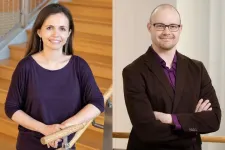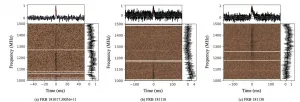(Press-News.org) Does a warmer climate mean more dry land? For years, researchers projected that drylands -- including deserts, savannas and shrublands -- will expand as the planet warms, but new research from the Harvard John A. Paulson School of Engineering and Applied Sciences (SEAS) challenges those prevailing views.
Previous studies used atmospheric information, including rainfall and temperature, to make projections about future land conditions. The real picture is more complicated than that, said Kaighin McColl, Assistant Professor of Earth and Planetary Sciences and of Environmental Science and Engineering at SEAS and senior author of the paper.
"Historically, we have relatively good records of rainfall and temperature but really poor records of the land surface, things like soil moisture and vegetation," said McColl. "As a result, previous definitions of drylands are based only on how the atmosphere is behaving, as an approximation of the land surface. But models can now simulate both atmospheric and land conditions. By just looking directly at the land surface in climate models, we find that the models aren't showing a clear increase of drylands over time and that there is huge uncertainty about the global average state of drylands in the future."
The research is published in Nature Climate Change.
"If you want to know if the land is going to get drier, if crops are going to fail or if a forest is going to dry out, you have look at the land itself," said Alexis Berg, a research associate in McColl's lab and first author of the paper. "How much vegetation is there? Are the plants water stressed?"
While climate models have historically focused on the atmosphere, modern climate models now also simulate vegetation behavior and land hydrology.
For example, when plants absorb CO2, they lose water. If there is more CO2 in the air, plants can release less water and become more water efficient. More CO2 also results in more fertilizer for plants, which helps them grow and reduces water stress.
These effects have long been known, but previous atmospheric-only indicators of drylands just weren't capturing these land surface effects.
"As the climate is warming, there is a divergence between atmospheric and land surface behavior," said Berg.
To account for that divergence, McColl and Berg developed a new metric of drylands, based on land surface properties, including biological responses to higher atmospheric CO2, and compared drylands projections to those derived solely from atmospheric metrics.
"Our research shows that while some drylands may expand, climate models don't project that there will be a dramatic and rapid global expansion of drylands," said McColl.
However, simulating complex land processes remains challenging in global models.
"There is still a lot of uncertainty about how vegetation and the water cycle will change in a warming world," said McColl.
McColl and his team aim to reduce that uncertainty in future research by developing more accurate land surface models.
INFORMATION:
This research was supported in part by a Winokur Seed Grant in Environmental Sciences from the Harvard University Center for the Environment.
AMES, Iowa - Parents would never give their children the keys to the car without supervised training and driver's education. An Iowa State University researcher says parents and educators need to take a similar approach before handing children a keyboard to access the digital world.
ISU psychology professor Douglas Gentile worked with the DQ (Digital Intelligence) Institute, an international think tank, to design a framework for digital literacy education. In a commentary, published by the journal Nature Human Behaviour, Gentile and his colleagues outlined how the COVID-19 pandemic has accelerated ...
What do you do after solving the answer to life, the universe, and everything? If you're mathematicians Drew Sutherland and Andy Booker, you go for the harder problem.
In 2019, Booker, at the University of Bristol, and Sutherland, principal research scientist at MIT, were the first to find the answer to 42. The number has pop culture significance as the fictional answer to "the ultimate question of life, the universe, and everything," as Douglas Adams famously penned in his novel "The Hitchhiker's Guide to the Galaxy." The question that begets 42, at least in the ...
CHAMPAIGN, Ill. -- Charitable donations account for about 2% of gross domestic product in the U.S., but it's not well-understood whether an event such as a deadly storm inspires increases in charitable giving or simply reallocates a fixed supply of donation dollars that would have otherwise gone to another cause.
A new paper from a team of University of Illinois Urbana-Champaign experts finds that, in the aftermath of catastrophic tornadoes, charitable giving to alleviate an unanticipated event doesn't necessarily crowd out monetary donations to ...
Millions of people die prematurely every year from diseases and cancer caused by air pollution. The first line of defence against this carnage is ambient air quality standards. Yet, according to researchers from McGill University, over half of the world's population lives without the protection of adequate air quality standards.
Air pollution varies greatly in different parts of the world. But what about the primary weapons against it? To find answers, researchers from McGill University set out to investigate global air quality standards in a study published ...
The idea was so far-fetched it seemed like science fiction: create an observatory out of a one cubic kilometer block of ice in Antarctica to track ghostly particles called neutrinos that pass through the Earth. But speaking to Benedickt Riedel, global computing manager at the IceCube Neutrino Observatory, it makes perfect sense.
"Constructing a comparable observatory anywhere else would be astronomically expensive," Riedel explained. "Antarctica ice is a great optical material and allows us to sense neutrinos as nowhere else."
Neutrinos are neutral subatomic particles with a mass close to zero that can pass through solid materials at near the speed of light, rarely reacting with normal matter. They were first detected in the 1950s in experiments that operated ...
Scientists using NASA's Hubble Space Telescope have found evidence that a planet orbiting a distant star may have lost its atmosphere but gained a second one through volcanic activity.
The planet, GJ 1132 b, is hypothesized to have begun as a gaseous world with a thick hydrogen blanket of atmosphere. Starting out at several times the diameter of Earth, this so-called "sub-Neptune" is believed to have quickly lost its primordial hydrogen and helium atmosphere due to the intense radiation of the hot, young star it orbits. In a short period of time, such a planet would be stripped down to a bare core about the size of Earth. That's when things got interesting.
To the surprise of astronomers, Hubble observed an ...
ROCHESTER, Minn. -- Ten days after receiving a second dose of a messenger RNA, or mRNA, vaccine for COVID-19, patients without COVID-19 symptoms are far less likely to test positive and unknowingly spread COVID-19, compared to patients who have not been vaccinated for COVID-19. The Pfizer-BioNTech and Moderna messenger RNA vaccines for COVID-19 are authorized for emergency use in the U.S.
With two doses of a messenger RNA COVID-19 vaccine, people with no symptoms showed an 80% lower adjusted risk of testing positive for COVID-19 after their last dose. Those are the findings of a Mayo Clinic study of vaccinated patients. These finding appear in the journal Clinical Infectious Diseases.
The authors say these findings underscore ...
A study conducted by researchers at the University of Rochester Medical Center (URMC) - in collaboration with several other universities - indicates that breastfeeding women with COVID-19 do not transmit the SARS-CoV-2 virus through their milk, but do confer milk-borne antibodies that are able to neutralize the virus.
The study, "Characterization of SARS-CoV-2 RNA, antibodies, and neutralizing capacity in milk produced by women with COVID-19," published on February 9 in the journal mBio - analyzed 37 milk samples submitted by 18 women diagnosed with COVID-19. None of the milk samples were found to contain ...
Fast radio burst (FRB) is a kind of mysterious radio flashes lasting only a few thousandths of a second. Confirmed to be the cosmological origin in 2016, FRB has the potential to provide insights into a wide range of astrophysical problems.
Dr. NIU Chenhui from the team led by Dr. LI Di and Dr. ZHU Weiwei from National Astronomical Observatories of Chinese Academy of Sciences discovered three new FRBs with high dispersion measure from the massive data of the Five-hundred-meter Aperture Spherical radio Telescope (FAST).
Their findings were published in The Astrophysical Journal Letters on March 3.
The discovery indicated that these three FRBs happened billions of years ago when the ...
Intrauterine growth restriction (IUGR) is common and concerning, but few therapeutic options exist for pregnant mothers who receive this diagnosis. IUGR is a condition in which a baby in the womb is measuring small for its gestational age, often because of issues with the placenta, resulting in compromised or insufficient transfer of oxygen and nutrients to the growing fetus. The developing fetal brain is particularly vulnerable to these effects. One out of every 10 babies is diagnosed with IUGR, and infants with IUGR are at increased risk of death and neurodevelopmental impairment. ...



